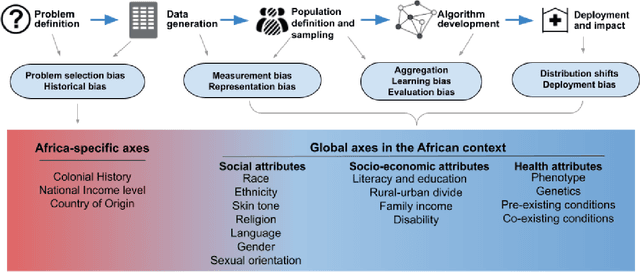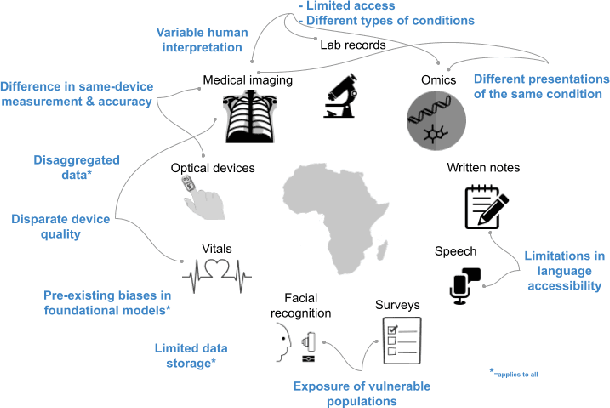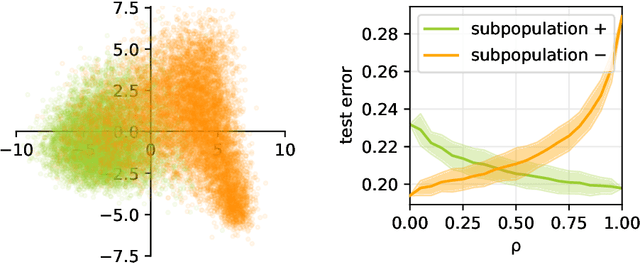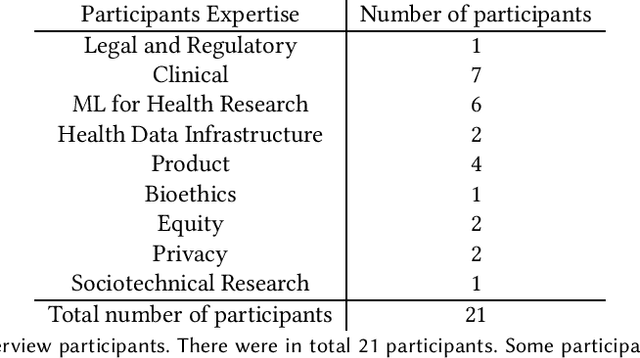Negar Rostamzadeh
Cultural Evaluations of Vision-Language Models Have a Lot to Learn from Cultural Theory
May 28, 2025Abstract:Modern vision-language models (VLMs) often fail at cultural competency evaluations and benchmarks. Given the diversity of applications built upon VLMs, there is renewed interest in understanding how they encode cultural nuances. While individual aspects of this problem have been studied, we still lack a comprehensive framework for systematically identifying and annotating the nuanced cultural dimensions present in images for VLMs. This position paper argues that foundational methodologies from visual culture studies (cultural studies, semiotics, and visual studies) are necessary for cultural analysis of images. Building upon this review, we propose a set of five frameworks, corresponding to cultural dimensions, that must be considered for a more complete analysis of the cultural competencies of VLMs.
Understanding the Local Geometry of Generative Model Manifolds
Aug 15, 2024



Abstract:Deep generative models learn continuous representations of complex data manifolds using a finite number of samples during training. For a pre-trained generative model, the common way to evaluate the quality of the manifold representation learned, is by computing global metrics like Fr\'echet Inception Distance using a large number of generated and real samples. However, generative model performance is not uniform across the learned manifold, e.g., for \textit{foundation models} like Stable Diffusion generation performance can vary significantly based on the conditioning or initial noise vector being denoised. In this paper we study the relationship between the \textit{local geometry of the learned manifold} and downstream generation. Based on the theory of continuous piecewise-linear (CPWL) generators, we use three geometric descriptors - scaling ($\psi$), rank ($\nu$), and complexity ($\delta$) - to characterize a pre-trained generative model manifold locally. We provide quantitative and qualitative evidence showing that for a given latent, the local descriptors are correlated with generation aesthetics, artifacts, uncertainty, and even memorization. Finally we demonstrate that training a \textit{reward model} on the local geometry can allow controlling the likelihood of a generated sample under the learned distribution.
Position: Cracking the Code of Cascading Disparity Towards Marginalized Communities
Jun 03, 2024
Abstract:The rise of foundation models holds immense promise for advancing AI, but this progress may amplify existing risks and inequalities, leaving marginalized communities behind. In this position paper, we discuss that disparities towards marginalized communities - performance, representation, privacy, robustness, interpretability and safety - are not isolated concerns but rather interconnected elements of a cascading disparity phenomenon. We contrast foundation models with traditional models and highlight the potential for exacerbated disparity against marginalized communities. Moreover, we emphasize the unique threat of cascading impacts in foundation models, where interconnected disparities can trigger long-lasting negative consequences, specifically to the people on the margin. We define marginalized communities within the machine learning context and explore the multifaceted nature of disparities. We analyze the sources of these disparities, tracing them from data creation, training and deployment procedures to highlight the complex technical and socio-technical landscape. To mitigate the pressing crisis, we conclude with a set of calls to action to mitigate disparity at its source.
A Toolbox for Surfacing Health Equity Harms and Biases in Large Language Models
Mar 18, 2024Abstract:Large language models (LLMs) hold immense promise to serve complex health information needs but also have the potential to introduce harm and exacerbate health disparities. Reliably evaluating equity-related model failures is a critical step toward developing systems that promote health equity. In this work, we present resources and methodologies for surfacing biases with potential to precipitate equity-related harms in long-form, LLM-generated answers to medical questions and then conduct an empirical case study with Med-PaLM 2, resulting in the largest human evaluation study in this area to date. Our contributions include a multifactorial framework for human assessment of LLM-generated answers for biases, and EquityMedQA, a collection of seven newly-released datasets comprising both manually-curated and LLM-generated questions enriched for adversarial queries. Both our human assessment framework and dataset design process are grounded in an iterative participatory approach and review of possible biases in Med-PaLM 2 answers to adversarial queries. Through our empirical study, we find that the use of a collection of datasets curated through a variety of methodologies, coupled with a thorough evaluation protocol that leverages multiple assessment rubric designs and diverse rater groups, surfaces biases that may be missed via narrower evaluation approaches. Our experience underscores the importance of using diverse assessment methodologies and involving raters of varying backgrounds and expertise. We emphasize that while our framework can identify specific forms of bias, it is not sufficient to holistically assess whether the deployment of an AI system promotes equitable health outcomes. We hope the broader community leverages and builds on these tools and methods towards realizing a shared goal of LLMs that promote accessible and equitable healthcare for all.
The Case for Globalizing Fairness: A Mixed Methods Study on Colonialism, AI, and Health in Africa
Mar 11, 2024

Abstract:With growing application of machine learning (ML) technologies in healthcare, there have been calls for developing techniques to understand and mitigate biases these systems may exhibit. Fair-ness considerations in the development of ML-based solutions for health have particular implications for Africa, which already faces inequitable power imbalances between the Global North and South.This paper seeks to explore fairness for global health, with Africa as a case study. We conduct a scoping review to propose axes of disparities for fairness consideration in the African context and delineate where they may come into play in different ML-enabled medical modalities. We then conduct qualitative research studies with 672 general population study participants and 28 experts inML, health, and policy focused on Africa to obtain corroborative evidence on the proposed axes of disparities. Our analysis focuses on colonialism as the attribute of interest and examines the interplay between artificial intelligence (AI), health, and colonialism. Among the pre-identified attributes, we found that colonial history, country of origin, and national income level were specific axes of disparities that participants believed would cause an AI system to be biased.However, there was also divergence of opinion between experts and general population participants. Whereas experts generally expressed a shared view about the relevance of colonial history for the development and implementation of AI technologies in Africa, the majority of the general population participants surveyed did not think there was a direct link between AI and colonialism. Based on these findings, we provide practical recommendations for developing fairness-aware ML solutions for health in Africa.
From plane crashes to algorithmic harm: applicability of safety engineering frameworks for responsible ML
Oct 06, 2022


Abstract:Inappropriate design and deployment of machine learning (ML) systems leads to negative downstream social and ethical impact -- described here as social and ethical risks -- for users, society and the environment. Despite the growing need to regulate ML systems, current processes for assessing and mitigating risks are disjointed and inconsistent. We interviewed 30 industry practitioners on their current social and ethical risk management practices, and collected their first reactions on adapting safety engineering frameworks into their practice -- namely, System Theoretic Process Analysis (STPA) and Failure Mode and Effects Analysis (FMEA). Our findings suggest STPA/FMEA can provide appropriate structure toward social and ethical risk assessment and mitigation processes. However, we also find nontrivial challenges in integrating such frameworks in the fast-paced culture of the ML industry. We call on the ML research community to strengthen existing frameworks and assess their efficacy, ensuring that ML systems are safer for all people.
Inducing bias is simpler than you think
May 31, 2022



Abstract:Machine learning may be oblivious to human bias but it is not immune to its perpetuation. Marginalisation and iniquitous group representation are often traceable in the very data used for training, and may be reflected or even enhanced by the learning models. To counter this, some of the model accuracy can be traded off for a secondary objective that helps prevent a specific type of bias. Multiple notions of fairness have been proposed to this end but recent studies show that some fairness criteria often stand in mutual competition. In the present work, we introduce a solvable high-dimensional model of data imbalance, where parametric control over the many bias-inducing factors allows for an extensive exploration of the bias inheritance mechanism. Through the tools of statistical physics, we analytically characterise the typical behaviour of learning models trained in our synthetic framework and find similar unfairness behaviours as those observed on more realistic data. However, we also identify a positive transfer effect between the different subpopulations within the data. This suggests that mixing data with different statistical properties could be helpful, provided the learning model is made aware of this structure. Finally, we analyse the issue of bias mitigation: by reweighing the various terms in the training loss, we indirectly minimise standard unfairness metrics and highlight their incompatibilities. Leveraging the insights on positive transfer, we also propose a theory-informed mitigation strategy, based on the introduction of coupled learning models. By allowing each model to specialise on a different community within the data, we find that multiple fairness criteria and high accuracy can be achieved simultaneously.
Evaluation Gaps in Machine Learning Practice
May 11, 2022



Abstract:Forming a reliable judgement of a machine learning (ML) model's appropriateness for an application ecosystem is critical for its responsible use, and requires considering a broad range of factors including harms, benefits, and responsibilities. In practice, however, evaluations of ML models frequently focus on only a narrow range of decontextualized predictive behaviours. We examine the evaluation gaps between the idealized breadth of evaluation concerns and the observed narrow focus of actual evaluations. Through an empirical study of papers from recent high-profile conferences in the Computer Vision and Natural Language Processing communities, we demonstrate a general focus on a handful of evaluation methods. By considering the metrics and test data distributions used in these methods, we draw attention to which properties of models are centered in the field, revealing the properties that are frequently neglected or sidelined during evaluation. By studying these properties, we demonstrate the machine learning discipline's implicit assumption of a range of commitments which have normative impacts; these include commitments to consequentialism, abstractability from context, the quantifiability of impacts, the limited role of model inputs in evaluation, and the equivalence of different failure modes. Shedding light on these assumptions enables us to question their appropriateness for ML system contexts, pointing the way towards more contextualized evaluation methodologies for robustly examining the trustworthiness of ML models
Disability prediction in multiple sclerosis using performance outcome measures and demographic data
Apr 08, 2022



Abstract:Literature on machine learning for multiple sclerosis has primarily focused on the use of neuroimaging data such as magnetic resonance imaging and clinical laboratory tests for disease identification. However, studies have shown that these modalities are not consistent with disease activity such as symptoms or disease progression. Furthermore, the cost of collecting data from these modalities is high, leading to scarce evaluations. In this work, we used multi-dimensional, affordable, physical and smartphone-based performance outcome measures (POM) in conjunction with demographic data to predict multiple sclerosis disease progression. We performed a rigorous benchmarking exercise on two datasets and present results across 13 clinically actionable prediction endpoints and 6 machine learning models. To the best of our knowledge, our results are the first to show that it is possible to predict disease progression using POMs and demographic data in the context of both clinical trials and smartphone-base studies by using two datasets. Moreover, we investigate our models to understand the impact of different POMs and demographics on model performance through feature ablation studies. We also show that model performance is similar across different demographic subgroups (based on age and sex). To enable this work, we developed an end-to-end reusable pre-processing and machine learning framework which allows quicker experimentation over disparate MS datasets.
Healthsheet: Development of a Transparency Artifact for Health Datasets
Feb 26, 2022
Abstract:Machine learning (ML) approaches have demonstrated promising results in a wide range of healthcare applications. Data plays a crucial role in developing ML-based healthcare systems that directly affect people's lives. Many of the ethical issues surrounding the use of ML in healthcare stem from structural inequalities underlying the way we collect, use, and handle data. Developing guidelines to improve documentation practices regarding the creation, use, and maintenance of ML healthcare datasets is therefore of critical importance. In this work, we introduce Healthsheet, a contextualized adaptation of the original datasheet questionnaire ~\cite{gebru2018datasheets} for health-specific applications. Through a series of semi-structured interviews, we adapt the datasheets for healthcare data documentation. As part of the Healthsheet development process and to understand the obstacles researchers face in creating datasheets, we worked with three publicly-available healthcare datasets as our case studies, each with different types of structured data: Electronic health Records (EHR), clinical trial study data, and smartphone-based performance outcome measures. Our findings from the interviewee study and case studies show 1) that datasheets should be contextualized for healthcare, 2) that despite incentives to adopt accountability practices such as datasheets, there is a lack of consistency in the broader use of these practices 3) how the ML for health community views datasheets and particularly \textit{Healthsheets} as diagnostic tool to surface the limitations and strength of datasets and 4) the relative importance of different fields in the datasheet to healthcare concerns.
 Add to Chrome
Add to Chrome Add to Firefox
Add to Firefox Add to Edge
Add to Edge